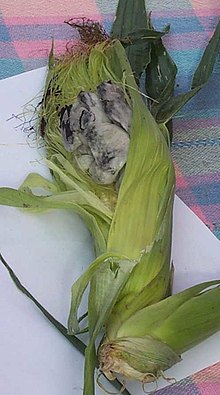Ustilaginaceae
| Ustilaginaceae | |
|---|---|

| |
| Ustilago maydis | |
| Scientific classification | |
| Domain: | Eukaryota |
| Kingdom: | Fungi |
| Division: | Basidiomycota |
| Class: | Ustilaginomycetes |
| Order: | Ustilaginales |
| Family: | Ustilaginaceae Tul. & C.Tul. (1847) |
| Type genus | |
| Ustilago (Pers.) Roussel (1806)
| |
The Ustilaginaceae are a family of smut fungi in the order Ustilaginomycetes. Collectively, the family contains 17 genera and 607 species.[1]
Biotechnological relevance
[edit]Ustilaginaceae naturally produce a wide range of value-added chemicals (e.g. secondary metabolites, TCA cycle intermediates) with growing biotechnological interest.[2] Reported metabolites are polyols, organic acids, extracellular glycolipids, iron-chelating siderophores and tryptophan derivatives.[3][4] Polyols, such as erythritol (ery) and mannitol, for example, have large markets as sweeteners for diabetics and as facilitating agents for the transportation of pharmaceuticals in medicine.[5] Itaconic, L-malic, succinic, l-itatartaric, and l-2-hydroxyparaconic acid are organic acids produced by many Ustilaginomycetes.[4] Applications for itaconic acid are for example the production of resins, plastics, adhesives, elastomers, coatings, and nowadays itaconate is discussed as a platform chemical in the production of biofuels.[6] Malic acid is used in many food products, primarily as an acidulant.[7] Succinic acid is utilized as a precursor to pharmaceutical ingredients, such as additives, solvents, and polymers, but also as a food additive and dietary supplement.[8] Another category of metabolites produced by smut fungi contains extracellular glycolipids, such as mannosylerythritol lipids and ustilagic acid.[9][10] These lipids have biosurfactant properties and can be used in pharmaceutical, cosmetic, and food applications and are known for their strong fungicidal activity on many species.[3]
Genera
[edit]With authors and amount of species per genus;[11]
- Ahmadiago Vánky (1)
- Aizoago Vánky (2)
- Anomalomyces Vánky, M. Lutz & R.G. Shivas (2)
- Anthracocystis Bref. (134)
- Bambusiomyces Vánky (1)[12]
- Centrolepidosporium R.G. Shivas & Vánky (1)
- Dirkmeia F.Y. Bai, Q.M. Wang, Begerow & Boekhout (1)
- Eriocaulago Vánky (2)
- Eriomoeszia Vánky (1)
- Eriosporium (E. Müll.) Vánky (2)
- Franzpetrakia Thirum. & Pavgi (3)
- Kalmanozyma Q.M. Wang, F.Y. Bai, Begerow & Boekhout (3)
- Langdonia McTaggart & R.G. Shivas (8)
- Macalpinomyces Langdon & Full. (41)
- Melanopsichium Beck (2)
- Moesziomyces Vánky (7)
- Parvulago R. Bauer, M. Lutz, Piątek, Vánky & Oberw. (1)
- Pattersoniomyces Piątek, M. Lutz & C.A. Rosa (1)
- Shivasia Vánky, M. Lutz & Piątek (1)
- Sporisorium Ehrenb. ex Link (195)
- Stollia McTaggart & R.G. Shivas (5)
- Tranzscheliella Lavrov (17)
- Triodiomyces McTaggart & R.G. Shivas (6)
- Ustilago (Pers.) Roussel (170)
- Yunchangia L. Guo & B. Xu (1)
References
[edit]- ^ Kirk MP, Cannon PF, Minter DW, Stalpers JA (2008). Dictionary of the Fungi (10th ed.). Wallingford, UK: CAB International. p. 716. ISBN 978-0-85199-826-8.
- ^ Geiser, Elena; Wiebach, Vincent; Wierckx, Nick; Blank, Lars M. (2014-01-01). "Prospecting the biodiversity of the fungal family Ustilaginaceae for the production of value-added chemicals". Fungal Biology and Biotechnology. 1: 2. doi:10.1186/s40694-014-0002-y. ISSN 2054-3085. PMC 5598272. PMID 28955444.
- ^ a b Feldbrügge, Michael; Kellner, Ronny; Schipper, Kerstin (2013-03-02). "The biotechnological use and potential of plant pathogenic smut fungi". Applied Microbiology and Biotechnology. 97 (8): 3253–3265. doi:10.1007/s00253-013-4777-1. ISSN 0175-7598. PMID 23455565. S2CID 18520974.
- ^ a b Guevarra, Elvira D.; Tabuchi, Takeshi (1990-01-01). "Accumulation of Itaconic, 2-Hydroxyparaconic, Itatartaric, and Malic Acids by Strains of the Genus Ustilago". Agricultural and Biological Chemistry. 54 (9): 2353–2358. doi:10.1271/bbb1961.54.2353.
- ^ Moon, Hee-Jung; Jeya, Marimuthu; Kim, In-Won; Lee, Jung-Kul (2010-02-26). "Biotechnological production of erythritol and its applications". Applied Microbiology and Biotechnology. 86 (4): 1017–1025. doi:10.1007/s00253-010-2496-4. ISSN 0175-7598. PMID 20186409. S2CID 9560435.
- ^ Willke, Th; Vorlop, K.-D. (2001). "Biotechnological production of itaconic acid". Applied Microbiology and Biotechnology. 56 (3–4): 289–295. doi:10.1007/s002530100685. ISSN 0175-7598. PMID 11548996. S2CID 206934753.
- ^ Tsao, G. T.; Cao, N. J.; Du, J.; Gong, C. S. (1999-01-01). Tsao, Prof Dr G. T.; Brainard, A. P.; Bungay, H. R.; Cao, N. J.; Cen, P.; Chen, Z.; Du, J.; Foody, B.; Gong, C. S. (eds.). Production of Multifunctional Organic Acids from Renewable Resources. Advances in Biochemical Engineering/Biotechnology. Vol. 65. Springer Berlin Heidelberg. pp. 243–280. doi:10.1007/3-540-49194-5_10. ISBN 9783540655770. PMID 10533437.
- ^ Zeikus, J. G.; Jain, M. K.; Elankovan, P. (1999). "Biotechnology of succinic acid production and markets for derived industrial products". Applied Microbiology and Biotechnology. 51 (5): 545–552. doi:10.1007/s002530051431. ISSN 0175-7598. S2CID 38868987.
- ^ Morita, Tomotake; Fukuoka, Tokuma; Imura, Tomohiro; Kitamoto, Dai (2009-05-01). "Production of glycolipid biosurfactants by basidiomycetous yeasts". Biotechnology and Applied Biochemistry. 53 (1): 39–49. doi:10.1042/BA20090033. ISSN 1470-8744. PMID 19341364. S2CID 27322169.
- ^ Bölker, Michael; Basse, Christoph W.; Schirawski, Jan (2008-08-01). "Ustilago maydis secondary metabolism—From genomics to biochemistry". Fungal Genetics and Biology. Thematic Issue: Ustilago maydis. 45, Supplement 1: S88 – S93. doi:10.1016/j.fgb.2008.05.007. PMID 18585066.
- ^ Wijayawardene, Nalin; Hyde, Kevin; Al-Ani, Laith Khalil Tawfeeq; Somayeh, Dolatabadi; Stadler, Marc; Haelewaters, Danny; et al. (2020). "Outline of Fungi and fungus-like taxa". Mycosphere. 11: 1060–1456. doi:10.5943/mycosphere/11/1/8. hdl:10481/61998.
- ^ Vánky K. (2011). "Bambusiomyces, a new genus of smut fungi" (PDF). Mycologia Balcanica. 8: 141–5. Archived from the original (PDF) on 2013-11-12.
External links
[edit]
